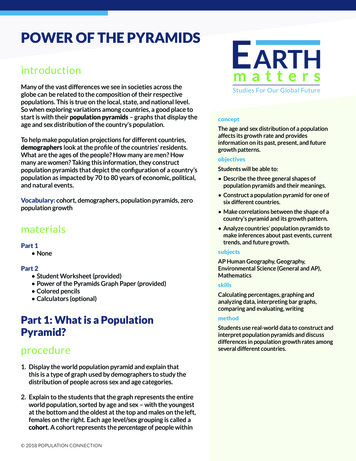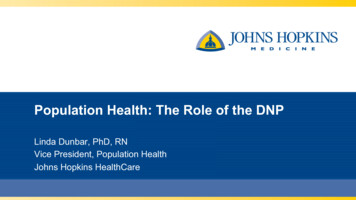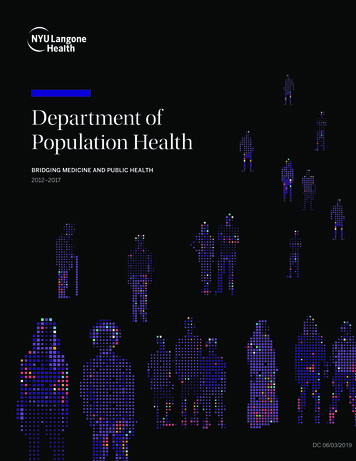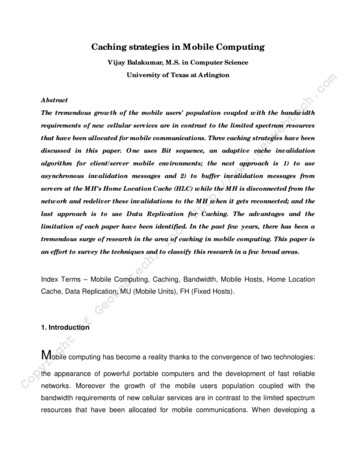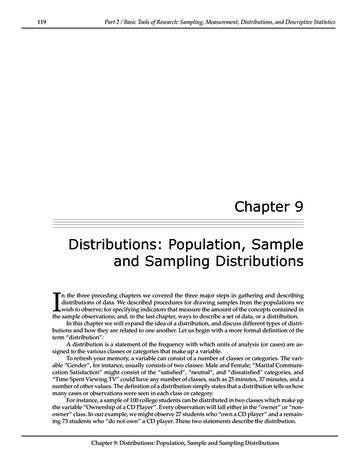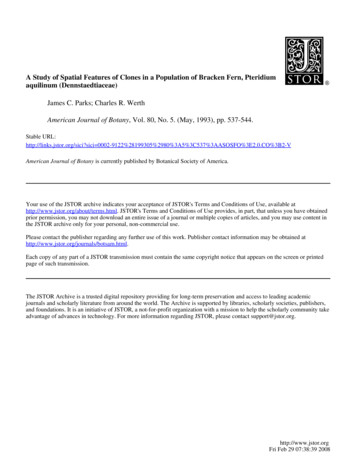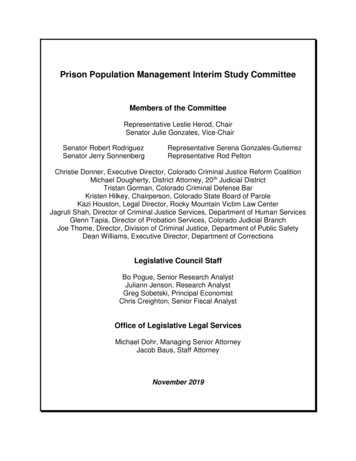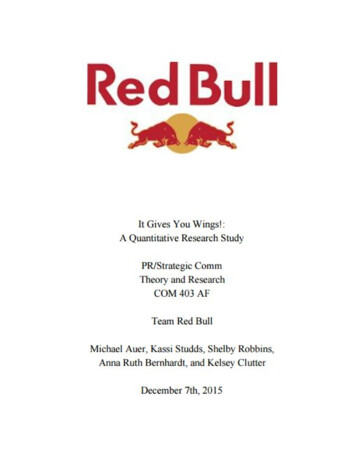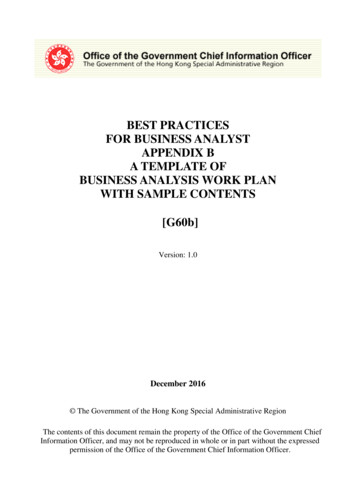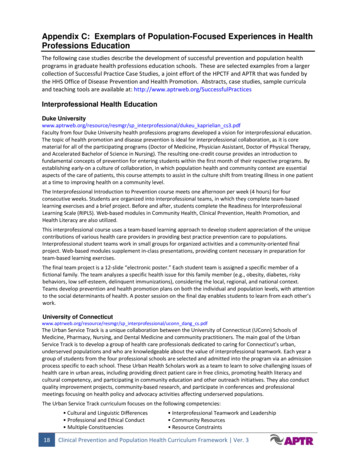
Transcription
Appendix C: Exemplars of Population-Focused Experiences in HealthProfessions EducationThe following case studies describe the development of successful prevention and population healthprograms in graduate health professions education schools. These are selected examples from a largercollection of Successful Practice Case Studies, a joint effort of the HPCTF and APTR that was funded bythe HHS Office of Disease Prevention and Health Promotion. Abstracts, case studies, sample curriculaand teaching tools are available at: fessional Health EducationDuke Universitywww.aptrweb.org/resource/resmgr/sp interprofessional/dukeu kaprielian cs3.pdfFaculty from four Duke University health professions programs developed a vision for interprofessional education.The topic of health promotion and disease prevention is ideal for interprofessional collaboration, as it is corematerial for all of the participating programs (Doctor of Medicine, Physician Assistant, Doctor of Physical Therapy,and Accelerated Bachelor of Science in Nursing). The resulting one‐credit course provides an introduction tofundamental concepts of prevention for entering students within the first month of their respective programs. Byestablishing early‐on a culture of collaboration, in which population health and community context are essentialaspects of the care of patients, this course attempts to assist in the culture shift from treating illness in one patientat a time to improving health on a community level.The Interprofessional Introduction to Prevention course meets one afternoon per week (4 hours) for fourconsecutive weeks. Students are organized into interprofessional teams, in which they complete team‐basedlearning exercises and a brief project. Before and after, students complete the Readiness for InterprofessionalLearning Scale (RIPLS). Web‐based modules in Community Health, Clinical Prevention, Health Promotion, andHealth Literacy are also utilized.This interprofessional course uses a team‐based learning approach to develop student appreciation of the uniquecontributions of various health care providers in providing best practice prevention care to populations.Interprofessional student teams work in small groups for organized activities and a community‐oriented finalproject. Web‐based modules supplement in‐class presentations, providing content necessary in preparation forteam‐based learning exercises.The final team project is a 12‐slide “electronic poster.” Each student team is assigned a specific member of afictional family. The team analyzes a specific health issue for this family member (e.g., obesity, diabetes, riskybehaviors, low self‐esteem, delinquent immunizations), considering the local, regional, and national context.Teams develop prevention and health promotion plans on both the individual and population levels, with attentionto the social determinants of health. A poster session on the final day enables students to learn from each other’swork.University of Connecticutwww.aptrweb.org/resource/resmgr/sp interprofessional/uconn dang cs.pdfThe Urban Service Track is a unique collaboration between the University of Connecticut (UConn) Schools ofMedicine, Pharmacy, Nursing, and Dental Medicine and community practitioners. The main goal of the UrbanService Track is to develop a group of health care professionals dedicated to caring for Connecticut’s urban,underserved populations and who are knowledgeable about the value of interprofessional teamwork. Each year agroup of students from the four professional schools are selected and admitted into the program via an admissionprocess specific to each school. These Urban Health Scholars work as a team to learn to solve challenging issues ofhealth care in urban areas, including providing direct patient care in free clinics, promoting health literacy andcultural competency, and participating in community education and other outreach initiatives. They also conductquality improvement projects, community‐based research, and participate in conferences and professionalmeetings focusing on health policy and advocacy activities affecting underserved populations.The Urban Service Track curriculum focuses on the following competencies: Cultural and Linguistic Differences Professional and Ethical Conduct Multiple Constituencies18 Interprofessional Teamwork and Leadership Community Resources Resource ConstraintsClinical Prevention and Population Health Curriculum Framework Ver. 3
Population Health and Public Health Quality Improvement and Patient Safety Health Policy Advocacy Health Care Financing and ManagementThe Urban Service Track (UST) is a two‐year “add‐on” program that runs concurrently with the main curriculumwithin the four schools and provides its Scholars with enhanced learning opportunities. Students admitted into theprogram are designated as Urban Health Scholars and complete the UST curriculum in addition to the mainrequired curriculum for each respective school. Mastery of the 11 competencies described above is accomplishedvia community‐based patient care, advocacy, and research activities as well as active participation at 8 quarterlylearning retreats (4 per year). At each learning retreat, students are introduced to a different vulnerable patientpopulation to enhance their knowledge and understanding of health care issues and barriers specific to thatpopulation. Populations covered include: children and youth, the elderly, the homeless, immigrants and refugees,HIV positive patients, those with substance abuse histories and the incarcerated and ex‐offenders. Scholars arealso required to participate in at least 8‐10 field activities, depending on the specific curricular requirement of eachschool. All field activities are community‐based. They are focused on clinical care (e.g., blood pressure and kidneydisease screenings at health fairs or oral health screenings), education (e.g., nutrition education to seniors andchildren, oral health education, fall prevention awareness, community gardens, health careers awarenessprograms to K‐16 students), or advocacy (e.g., participation at the National Association of Community HealthCenters' Annual Policy and Issues Forum). Field activities are developed by the UST director and faculty inconjunction with community‐based agencies. A unique component of UST is the strong connection withcommunity partners such as community health centers, Hartford Department of Health, and primary careorganizations.Allied Health Education– Occupational HealthUniversity of Oklahomawww.aptrweb.org/resource/resmgr/sp allied health/uohsc hamilton cs.pdfOccupational therapy emphasizes the influence of the environment on public health. The program’s goalis to produce occupational therapy graduates who are prepared to work with groups and organizationsto address population and individual health needs through engagement in healthy occupations. Eachsemester, this sequence reinforces didactic learning while building proficiency and expandingcommunity and population foci. The curricular emphasis on public health content culminates in theseventh semester with OCTH 7192 Exploring Community Participation, the capstone course for service‐learning and community‐based practice. The purpose of this third‐year course is to introduce anddevelop community‐building skills. Students examine contemporary approaches to interventions incommunity settings, including needs assessment, community‐building, program development, fundingalternatives, identification and measurement of program outcomes, and program evaluation. Studentsassess needs of the participants, environmental contexts, and occupations to formulate hypotheses andwork with participants, students, and facility staff to suggest training and environmental modificationsto enhance occupational performance. For example, in several school settings, they recommendedenvironmental modifications to support attention in classrooms, designed an anti‐bullying pro‐socialcurriculum, taught emotional regulation and coping skills activities, and promoted exercise and outdooractivity for children ages 2‐11 years old. In the living area of a private school, students assessed hazardsand implemented environmental modifications by modifying laundry baskets and placing safetyequipment in bathrooms.Allied Health Education– Nutrition and ExerciseSacred Heart Universitywww.aptrweb.org/resource/resmgr/sp allied health/sacredheartu bjerke.cs.pdfFit Kids is a nutrition education and physical activity program created collaboratively by the Norwalk HealthDepartment, Sacred Heart University, and Norwalk Community College in Connecticut. Undergraduate exercisescience students serve as interns and assist in leading/supervising nutrition education and physical activities forelementary school children. Childhood obesity prevalence in Norwalk, Connecticut reflects national trends. As aresult, the objectives of Fit Kids include increasing physical activity and healthy eating habits among children19Clinical Prevention and Population Health Curriculum Framework Ver. 3
enrolled in after school programs. These objectives match nutrition and physical activity content and curriculum inundergraduate exercise science courses at Sacred Heart University and Norwalk Community College in addition togoals and objectives of Healthy People 2020.The specific objectives of Fit Kids include a decrease in mean BMI and fat mass, an increase in lean body mass, andimproved indicators of fitness including upper body strength and lower extremity power. Fit Kids also seeks toincrease self‐confidence, self‐ efficacy (via validated tests) and knowledge of nutrition content measured via a preand post quiz.The preparation and administration of Fit Kids nutrition and physical activities by the students requires integrationof course content with transformative social engagement with the children and the professionals associated withthe program. Service learning is the primary pedagogy used including supporting lecture content and orientationsprovided by the health department. The program has attracted corporate sponsors and local politicians to eventsincluding the mayor of Norwalk. The intervention duration is 12 weeks consisting of two one‐hour sessions perweek including 30 minutes of nutrition education and 30 minutes of physical activity.The Fit Kids program assessed several variables among children in the intervention group and comparison group in2011. Decreased BMI and percent fat was observed in the intervention group as well as increases in strength,power, and self‐efficacy., The results from a standardized questionnaire that assesses undergraduate studentservice learning outcomes reveal that over 80% of student respondents found that activities were “relevant to thecourse” and “enhanced communication skills”.Dental EducationUniversity of California, Los AngelesThe overall goals of this course are to increase the predoctoral students’ awareness of oral health in thecommunity and the role of clinical dentistry in maintaining oral health and making dental services available, as wellas to increase the involvement of the dental profession in community events. Specifically, the course, titled“Community Oral Health Education, Screening and Service” offers students an opportunity to participate in acommunity event such as an educational health fair, workplace oral health education/screening, or communityhealth screening. Each event is characterized by its target population and community. Students learn about thetarget population; select appropriate educational materials; plan for adequate staffing, supplies, equipment andtransportation; prepare an attractive setting for their presentation at the event; use educational aids such asbrochures, videos and an intraoral camera for individualized health education; and use effective communicationsfor health education. Students are required to attend 5 one‐hour didactic sessions and participate in twocommunity oral health education events. The type of community events varies in duration from 3 to 7 hours.Credit is given for actual hours. Total 12‐18 hours. The didactic course covers the demographics of a community,facilities where fairs might be staged, and the actual operation and maintenance of the dental portable equipment.Students participate in Community Health Fairs throughout the greater Los Angeles metropolitan area. The scopeof services provided by dental students is oral health education, oral screening, topical fluoride application, anddental sealants. The majority of the fairs are held with the medical school, so dental students have an opportunityto interact with medical students. After attending two fairs, the students are required to attend a reflective sessionwhere they have an opportunity to discuss their experiences and discuss the characteristics of the differentcommunities where they provided services.Medical EducationKansas University School of Medicinewww.aptrweb.org/resource/resmgr/sp medicine/kansasu ellerbeck.cs.pdfTo promote competencies in population health, the University of Kansas developed a required 4‐week clerkshipwhich provides students with practical experiences in practice‐based learning and improvement (PBLI). In thisclerkship, student teams are matched with a clinician with a relevant PBLI project and assigned to a ‘methodsadvisor’ from the Department of Preventive Medicine and Public Health. Students receive 'just‐in‐time' training inthe classroom on issues related to project development and implementation. 20Week 1: Identify need/issue for a defined patient population; investigate current literature and projectmethodsWeek 2: Design project plan, develop data collection tools, and select statistical tests for evaluationClinical Prevention and Population Health Curriculum Framework Ver. 3
Week 3: Collect and analyze dataWeek 4: Present findingsStudent teams demonstrate progress on their PBLI project by meeting weekly with their methods advisor to reviewproject benchmarks. Within the past decade student teams have engaged in over 500 projects. Categories include:1) Community Aspects of Practice and Public Health (56%); 2) Outpatient Clinical Practice Improvement (20%); 3)Inpatient Clinical Practice Improvement (18%); 4) Medical Education (4%); and 5) Health Policy (2%). Studentsdemonstrated competency by successfully applying quality improvement methods to these focused populationhealth issues. The progress to‐date demonstrates that a 4‐week PBLI clerkship is feasible and can provide practicalquality improvement experiences in which students can achieve population health competencies.Health of the Public (HOP) is a required fourth‐year medical school clerkship offered three times in the academicyear: October, February and April. During this 4‐week clerkship students participate in interactive team‐basedlearning sessions, attend seminars, and work in teams on a population‐based health care project called their“capstone project.” The framework for this required team‐oriented clerkship grew out of the RMPHEC populationhealth competencies and the ACGME practice‐based learning and improvement (PBLI) competencies. The courselinks students with practicing clinicians or members of the community who are interested in studying or improvingclinical practice or addressing a health concern.Kirksville College of Osteopathic hic medicine/index.htmPrevention and holistic care for persons, families and populations are core aspects of osteopathic medicine. Assuch, the Kirksville College of Osteopathic Medicine, the founding school of osteopathic medicine, threads learningin evidence‐based medicine, social determinants of health, healthcare systems and health policy and communityfocused health across a two year Complete Doctor course within the department of Family Medicine, PreventiveMedicine and Community Health. Additionally, in the Osteopathic Theory and Methods course, students aretaught how to help patients maintain homeostasis thus maintaining health. These courses are designed toinculcate values, skills and knowledge leading to a well‐rounded student physician ready to address the complexneeds of patients, families and populations in a comprehensive manner.Early in a foundations section of material, the Healthy People Framework is introduced to students as benchmarksfor population health goals with a focus on preventive medicine. Additionally, four hours of principles of Evidence‐Based Medicine (EBM) learning takes place within this section of the curriculum. Within patient‐oriented systemssections (the remainder of years one and two), students are introduced to evidence‐based medicine didacticsappropriate for the system they are studying. The culmination of the evidence‐based medicine aspect of thecurriculum is juried poster presentations of students’ own topical EBM research.To help to address physician workforce distribution and, again, to stay true to their osteopathic heritage, theschool emphasizes primary care. Social determinants of health, vulnerable populations, health literacy andcultural awareness are all didactic components early in the curriculum. These frame the learner’s approach toclinical didactics across all courses. Healthcare systems and health policy are examined in the fourth semester priorto moving into clinical training sites. A day each spring is set aside to visit the state capitol to raise awareness ofvulnerable patient needs and the philosophy of osteopathic physicians. While not required, approximately 70% ofstudents make the two‐hour trip to talk to legislators.Learners have opportunity to explore some of these topics more deeply through elective coursework in VulnerablePopulations, Cultural Awareness in Medicine, Introduction to Public Health, and Health Partners. The latter teamsosteopathic medical students with nursing, speech and language disorders, dental and health science students tomake interprofessional house‐calls on elder patients, performing health screenings and surveying issues such asfall safety and healthcare utilization and needs.University of Massachusetts Worcester Family Medicine Residency Programhttp://www.aptrweb.org/resource/resmgr/sp medicine/umass deligiannidis.cs.pdfThe University of Massachusetts Worcester Family Medicine Residency is a GME grantee through the RegionalMedicine‐Public Health Education Center (RMPHEC) initiative, sponsored by the Association of American MedicalColleges and the Centers for Disease Control and Prevention. RMPHEC grantees were required to integratepublic/population health and prevention content into their curricula through collaborations with their local/statehealth agencies and other community partners. The goal of the revised curriculum is to foster a culture ofincorporating fundamental public health principles into everyday clinical practice. This integrated curriculum wasdesigned to enrich existing elements of the current residency structure through longitudinal as well as21Clinical Prevention and Population Health Curriculum Framework Ver. 3
concentrated experiences, interspersed throughout the three years of residency training. This strategy ofintegration has resulted in significant improvements in public health and prevention education, without stressingan already strained residency curriculum. This case study describes how one primary care residency integratedpublic health and prevention education into family medicine training to help residents acquire skills to improve apopulation’s health.The enriched curriculum has 5 elements: 1) chart rounds; 2) home visits; 3) resident workshops; 4) FamilyMedicine and Community Health (FMCH) rotation; and 5) senior projects. These elements are longitudinal: chartrounds are required daily, case‐based teaching conferences that occur at each of the residency’s outpatienttrainin
and Accelerated Bachelor of Science in Nursing). The resulting one‐credit course provides an introduction to . The Urban Service Track is a unique collaboration between the University of Connecticut (UConn) Schools of Medicine, Pharmacy, Nursing, and Dental Medicine an


